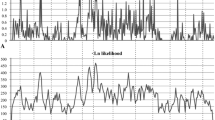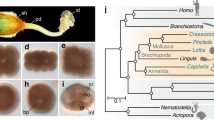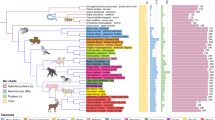Abstract
In mammals, the matrix extracellular phosphoglycoprotein (MEPE) is known to activate osteogenesis and mineralization via a particular region called dentonin, and to inhibit mineralization via its ASARM (acidic serine-aspartate rich MEPE-associated motif) peptide that also plays a role in phosphatemia regulation. In order to understand MEPE evolution in mammals, and particularly that of its functional regions, we conducted an evolutionary analysis based on the study of selective pressures. Using 37 mammalian sequences we: (1) confirmed the presence of an additional coding exon in most placentals; (2) highlighted several conserved residues and regions that could have important functions; (3) found that dentonin function was recruited in a placental ancestor; and (4) revealed that ASARM function was present earlier, pushing the recruitment of MEPE deep into amniote origins. Our data indicate that MEPE was involved in various functions (bone and eggshell mineralization) prior to acquiring those currently known in placental mammals.







Similar content being viewed by others
References
Rowe PS, de Zoysa PA, Dong R, Wang HR, White KE, Econs MJ, Oudet CL (2000) MEPE, a new gene expressed in bone marrow and tumors causing osteomalacia. Genomics 67:54–68
Petersen DN, Tkalcevic GT, Mansolf AL, Rivera-Gonzalez R, Brown TA (2000) Identification of osteoblast/osteocyte factor 45 (OF45), a bone-specific cDNA encoding an RGD-containing protein that is highly expressed in osteoblasts and osteocytes. J Biol Chem 275:36172–36180
Gowen LC, Petersen DN, Mansolf AL, Qi H, Stock JL, Tkalcevic GT, Simmons HA, Crawford DT, Chidsey-Frink KL, Ke HZ, McNeish JD, Brown TA (2003) Targeted disruption of the osteoblast/osteocyte factor 45 gene (OF45) results in increased bone formation and bone mass. J Biol Chem 278:1998–2007
Fisher LW, Fedarko NS (2003) Six genes expressed in bones and teeth encode the current members of the SIBLING family of proteins. Connect Tissue Res 44:33–40
Argiro L, Desbarats M, Glorieux FH, Ecarot B (2001) Mepe, the gene encoding a tumor-secreted protein in oncogenic hypophosphatemic osteomalacia, is expressed in bone. Genomics 74:342–351
Rowe PS (2004) The wrickkened pathways of FGF23, MEPE and PHEX. Crit Rev Oral Biol Med 15:264–281
Rowe PS, Kumagai Y, Gutierrez G, Garrett IR, Blacher R, Rosen D, Cundy J, Navvab S, Chen D, Drezner MK, Quarles LD, Mundy GR (2004) MEPE has the properties of an osteoblastic phosphatonin and minhibin. Bone 34:303–319
Addison WN, Nakano Y, Loisel T, Crine P, McKee MD (2008) MEPE-ASARM peptides control extracellular matrix mineralization by binding to hydroxyapatite: an inhibition regulated by PHEX cleavage of ASARM. J Bone Miner Res 23:1638–1649
Guo R, Rowe PS, Liu S, Simpson LG, Xiao ZS, Quarles LD (2002) Inhibition of MEPE cleavage by Phex. Biochem Biophys Res Commun 297:38–45
Hayashibara T, Hiraga T, Yi B, Nomizu M, Kumagai Y, Nishimura R, Yoneda T (2004) A synthetic peptide fragment of human MEPE stimulates new bone formation in vitro and in vivo. J Bone Miner Res 19:455–462
Liu H, Li W, Gao C, Kumagai Y, Blacher RW, DenBesten PK (2004) Dentonin, a fragment of MEPE, enhanced dental pulp stem cell proliferation. J Dent Res 83:496–499
Goldberg M, Lacerda-Pinheiro S, Jegat N, Six N, Septier D, Priam F, Bonnefoix M, Tompkins K, Chardin H, Denbesten P, Veis A, Poliard A (2006) The impact of bioactive molecules to stimulate tooth repair and regeneration as part of restorative dentistry. Dent Clin North Am 50:277–298, x
Delgado S, Casane D, Bonnaud L, Laurin M, Sire JY, Girondot M (2001) Molecular evidence for precambrian origin of amelogenin, the major protein of vertebrate enamel. Mol Biol Evol 18:2146–2153
Delgado S, Girondot M, Sire JY (2005) Molecular evolution of amelogenin in mammals. J Mol Evol 60:12–30
Delgado S, Couble ML, Magloire H, Sire JY (2006) Cloning, sequencing, and expression of the amelogenin gene in two scincid lizards. J Dent Res 85:138–143
Sire JY, Delgado S, Girondot M (2006) The amelogenin story: origin and evolution. Eur J Oral Sci 114(Suppl 1):64–77
Subramanian S, Kumar S (2006) Evolutionary anatomies of positions and types of disease-associated and neutral amino acid mutations in the human genome. BMC Genomics 7:306
Delgado S, Ishiyama M, Sire JY (2007) Validation of amelogenesis imperfecta inferred from amelogenin evolution. J Dent Res 86:326–330
Springer MS, Murphy WJ (2007) Mammalian evolution and biomedicine: new views from phylogeny. Biol Rev Camb Philos Soc 82:375–392
Rambaut A (1996) Se-Al sequence alignment editor. Zoology Department, University of Oxford, Oxford
Kosakovsky Pond SL, Frost SD, Muse SV (2005) HyPhy: hypothesis testing using phylogenies. Bioinformatics 21:676–679
Maddison DR, Maddison WP (2005) MacClade4 Version 4.08. Sinauer, Sunderland, Mass.
Doron-Faigenboim A, Stern A, Mayrose I, Bacharach E, Pupko T (2005) Selecton: a server for detecting evolutionary forces at a single amino-acid site. Bioinformatics 21:2101–2103
Stern A, Doron-Faigenboim A, Erez E, Martz E, Bacharach E, Pupko T (2007) Selecton 2007: advanced models for detecting positive and purifying selection using a Bayesian inference approach. Nucleic Acids Res 35:506–511
Tsunoyama K, Gojobori T (1998) Evolution of nicotinic acetylcholine receptor subunits. Mol Biol Evol 15:518–527
Hasegawa M, Kishino H, Yano T (1985) Dating of the human-ape splitting by a molecular clock of mitochondrial DNA. J Mol Evol 22:160–174
Kosakovsky Pond SL, Frost SD (2005) Datamonkey: rapid detection of selective pressure on individual sites of codon alignments. Bioinformatics 21:2531–2533
Kosakovsky Pond SL, Frost SD (2005) Not so different after all: a comparison of methods for detecting amino acid sites under selection. Mol Biol Evol 22:1208–1222
Tamura K, Nei M (1993) Estimation of the number of nucleotide substitutions in the control region of mitochondrial DNA in humans and chimpanzees. Mol Biol Evol 10:512–526
Saitou N, Nei M (1987) The neighbor-joining method: a new method for reconstructing phylogenetic trees. Mol Biol Evol 4:406–425
Murphy WJ, Pringle TH, Crider TA, Springer MS, Miller W (2007) Using genomic data to unravel the root of the placental mammal phylogeny. Genome Res 17:413–421
Hincke MT, Gautron J, Tsang CP, McKee MD, Nys Y (1999) Molecular cloning and ultrastructural localization of the core protein of an eggshell matrix proteoglycan, ovocleidin-116. J Biol Chem 274:32915–32923
Consortium ICS (2004) Sequence and comparative analysis of the chicken genome provide unique perspectives on vertebrate evolution. Nature 432:695–716
Kawasaki K, Weiss KM (2006) Evolutionary genetics of vertebrate tissue mineralization: the origin and evolution of the secretory calcium-binding phosphoprotein family. J Exp Zool B Mol Dev Evol 306:295–316
Horvat-Gordon M, Yu F, Burns D, Leach RM Jr (2008) Ovocleidin (OC 116) is present in avian skeletal tissues. Poult Sci 87:1618–1623
Warren WC, Hillier LW, Marshall Graves JA, Birney E, Ponting CP, Grutzner F, Belov K, Miller W, Clarke L, Chinwalla AT, Yang SP, Heger A, Locke DP, Miethke P, Waters PD, Veyrunes F, Fulton L, Fulton B, Graves T, Wallis J, Puente XS, López-Otín C, Ordóñez GR, Eichler EE, Chen L, Cheng Z, Deakin JE, Alsop A, Thompson K, Kirby P, Papenfuss AT, Wakefield MJ, Olender T, Lancet D, Huttley GA, Smit AF, Pask A, Temple-Smith P, Batzer MA, Walker JA, Konkel MK, Harris RS, Whittington CM, Wong ES, Gemmell NJ, Buschiazzo E, Vargas Jentzsch IM, Merkel A, Schmitz J, Zemann A, Churakov G, Kriegs JO, Brosius J, Murchison EP, Sachidanandam R, Smith C, Hannon GJ, Tsend-Ayush E, McMillan D, Attenborough R, Rens W, Ferguson-Smith M, Lefèvre CM, Sharp JA, Nicholas KR, Ray DA, Kube M, Reinhardt R, Pringle TH, Taylor J, Jones RC, Nixon B, Dacheux JL, Niwa H, Sekita Y, Huang X, Stark A, Kheradpour P, Kellis M, Flicek P, Chen Y, Webber C, Hardison R, Nelson J, Hallsworth-Pepin K, Delehaunty K, Markovic C, Minx P, Feng Y, Kremitzki C, Mitreva M, Glasscock J, Wylie T, Wohldmann P, Thiru P, Nhan MN, Pohl CS, Smith SM, Hou S, Nefedov M, de Jong PJ, Renfree MB, Mardis ER, Wilson RK (2008) Genome analysis of the platypus reveals unique signatures of evolution. Nature 453:175–183
Hughes RL, Carrick FN (1978) Reproduction in female monotremes. Aust Zool 20:233–253
Palmer BD, Guillette LJ (2004) Oviductal proteins and their influence on embryonic development in birds and reptiles. In: Deeming DC, Ferguson MWJ (eds) Egg incubation: its effects on embryonic development in birds and reptiles. Cambridge University Press, Cambridge, pp 29–46
Kawasaki K (2009) The SCPP gene repertoire in bony vertebrates and graded differences in mineralized tissues. Dev Genes Evol 219:147–157
Osada N, Hida M, Kusuda J, Tanuma R, Iseki K, Hirai M, Terao K, Suzuki Y, Sugano S, Hashimoto K (2000) Isolation of full-length cDNA clones from macaque brain cDNA libraries. [http://www.ncbi.nlm.nih.gov/nuccore/13874559]
Kawasaki K, Weiss KM (2003) Mineralized tissue and vertebrate evolution: the secretory calcium-binding phosphoprotein gene cluster. Proc Natl Acad Sci USA 100:4060–4065
Shintani S, Kamakura N, Kobata M, Toyosawa S, Onishi T, Sato A, Kawasaki K, Weiss KM, Ooshima T (2008) Identification and characterization of integrin-binding sialoprotein (IBSP) genes in reptile and amphibian. Gene 424:11–17
Yang R, Gerstenfeld LC (1997) Structural analysis and characterization of tissue and hormonal responsive expression of the avian bone sialoprotein (BSP) gene. J Cell Biochem 64:77–93
Tompa P (2002) Intrinsically unstructured proteins. Trends Biochem Sci 27:527–533
Chen JW, Romero P, Uversky VN, Dunker AK (2006) Conservation of intrinsic disorder in protein domains and families: II. functions of conserved disorder. J Proteome Res 5:888–898
Mann K, Hincke MT, Nys Y (2002) Isolation of ovocleidin-116 from chicken eggshells, correction of its amino acid sequence and identification of disulfide bonds and glycosylated Asn. Matrix Biol 21:383–387
Wang ET, Sandberg R, Luo S, Khrebtukova I, Zhang L, Mayr C, Kingsmore SF, Schroth GP, Burge CB (2008) Alternative isoform regulation in human tissue transcriptomes. Nature 456:470–476
Veis A (2003) Amelogenin gene splice products: potential signaling molecules. Cell Mol Life Sci 60:38–55
Narayanan K, Gajjeraman S, Ramachandran A, Hao J, George A (2006) Dentin matrix protein 1 regulates dentin sialophosphoprotein gene transcription during early odontoblast differentiation. J Biol Chem 281:19064–19071
Dunker AK, Oldfield CJ, Meng J, Romero P, Yang JY, Chen JW, Vacic V, Obradovic Z, Uversky VN (2008) The unfoldomics decade: an update on intrinsically disordered proteins. BMC Genomics 9:S1
Dee KC, Andersen TT, Bizios R (1998) Design and function of novel osteoblast-adhesive peptides for chemical modification of biomaterials. J Biomed Mater Res 40:371–377
Martin A, David V, Laurence JS, Schwarz PM, Lafer EM, Hedge AM, Rowe PS (2008) Degradation of MEPE, DMP1 and release of SIBLING ASARM-peptides (minhibins): ASARM-peptide(s) are directly responsible for defective mineralization in HYP. Endocrinology 149:1757–1772
Kasugai S, Zhang Q, Overall CM, Wrana JL, Butler WT, Sodek J (1991) Differential regulation of the 55 and 44 kDa forms of secreted phosphoprotein 1 (SPP-1, osteopontin) in normal and transformed rat bone cells by osteotropic hormones, growth factors and a tumor promoter. Bone Miner 13:235–250
Christensen B, Kazanecki CC, Petersen TE, Rittling SR, Denhardt DT, Sorensen ES (2007) Cell type-specific post-translational modifications of mouse osteopontin are associated with different adhesive properties. J Biol Chem 282:19463–19472
Boskey AL (1995) Osteopontin and related phosphorylated sialoproteins: effects on mineralization. Ann N Y Acad Sci 760:249–256
Ek-Rylander B, Flores M, Wendel M, Heinegard D, Andersson G (1994) Dephosphorylation of osteopontin and bone sialoprotein by osteoclastic tartrate-resistant acid phosphatase. Modulation of osteoclast adhesion in vitro. J Biol Chem 269:14853–14856
Al-Shami R, Sorensen ES, Ek-Rylander B, Andersson G, Carson DD, Farach-Carson MC (2005) Phosphorylated osteopontin promotes migration of human choriocarcinoma cells via a p70 S6 kinase-dependent pathway. J Cell Biochem 94:1218–1233
Bresler D, Bruder J, Mohnike K, Fraser WD, Rowe PS (2004) Serum MEPE-ASARM-peptides are elevated in X-linked rickets (HYP): implications for phosphaturia and rickets. J Endocrinol 183:R1–R9
Suzuki Y, Gojobori T (1999) A Method for detecting positive selection at single amino acid sites. Mol Biol Evol 16:1315–1328
Acknowledgments
We express our sincere thanks to IFRO (Institut Français pour la Recherche Odontologique) for financial support to CB and to Dr Matthew Vickarious (Ontario Veterinary College, University of Guelph, Canada) for English corrections. We also are grateful to Professor Jorge Cubo (UPMC) for his help in performing statistical analyses and to Dr Guillaume Achaz (UPMC) for helpful discussion. This work was supported by CNRS and UPMC (UMR 7138) grants.
Author information
Authors and Affiliations
Corresponding author
Electronic supplementary material
Below is the link to the electronic supplementary material.
18_2009_185_MOESM1_ESM.pdf
Alignment of the 37 amino acid sequences of mammalian MEPE. The human sequence was used as a reference sequence for this alignment, which takes into consideration mammalian relationships (see Fig. 1). Note that exon 3 and/or exon 4 are invalidated in some species. The 23 amino acid-long dentonin region (synthetical peptide AC-100) is located in the central region encoded by exon 5. It contains two important motifs, RGD and SGDG (boxed), which are preserved in most species. However, RGD is absent in several sequences and the two motifs are missing in marsupials. The amino acids of the ASARM peptide (Cterminus, boxed) are well conserved in all sequences studied, but in the two marsupials the ASARM sequence is followed by a dozen of residues. Newly identified important motifs are boxed in gray background. [ ] exon limits; (.) residue identical to human sequence; (-) Indel; (=) Unknown residue; (#) Residue identical in all sequences; (+) Residue identical in all therian sequences. (PDF 111 kb)
18_2009_185_MOESM2_ESM.jpg
Tree distance obtained using the distance matrix of the 37 mammalian MEPE. The relationships between species do not refelct current mammalian phylogeny (compare with Fig. 1). The species in which MEPE shows a high rate of evolution are artefactually attracted to the base of the tree (e.g., rodents and insectivores). (JPG 450 kb)
Rights and permissions
About this article
Cite this article
Bardet, C., Delgado, S. & Sire, JY. MEPE evolution in mammals reveals regions and residues of prime functional importance. Cell. Mol. Life Sci. 67, 305–320 (2010). https://doi.org/10.1007/s00018-009-0185-1
Received:
Revised:
Accepted:
Published:
Issue Date:
DOI: https://doi.org/10.1007/s00018-009-0185-1




